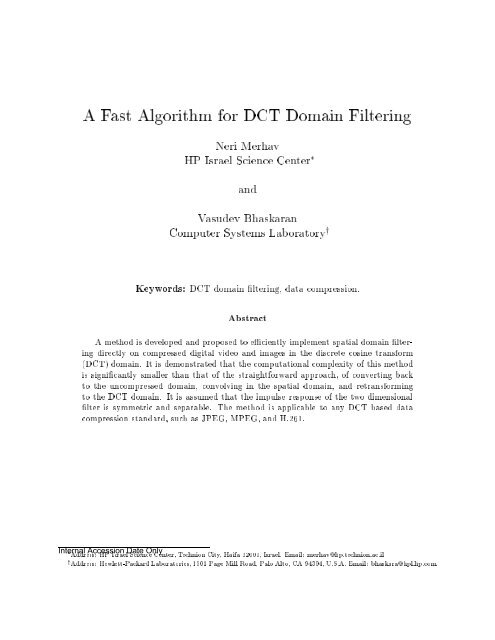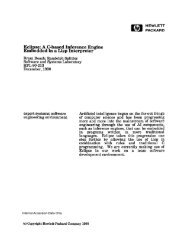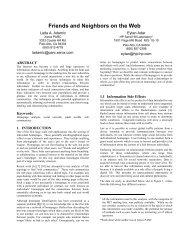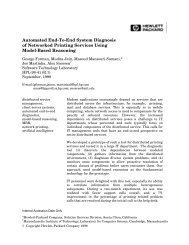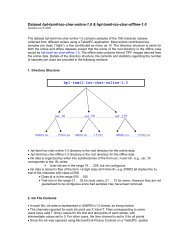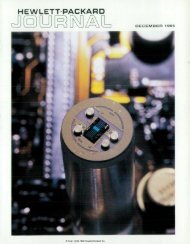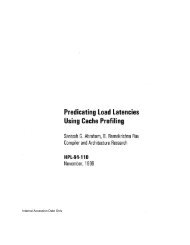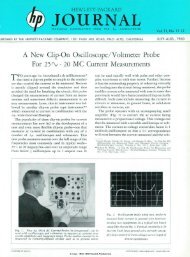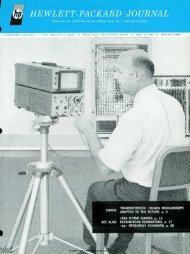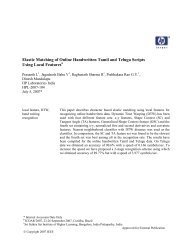A Fast Algorithm for DCT Domain Filtering
A Fast Algorithm for DCT Domain Filtering
A Fast Algorithm for DCT Domain Filtering
Create successful ePaper yourself
Turn your PDF publications into a flip-book with our unique Google optimized e-Paper software.
A<strong>Fast</strong> <strong>Algorithm</strong> <strong>for</strong> <strong>DCT</strong> <strong>Domain</strong> <strong>Filtering</strong><br />
Neri Merhav<br />
HP Israel Science Center <br />
and<br />
Vasudev Bhaskaran<br />
Computer Systems Laboratory y<br />
Keywords <strong>DCT</strong> domain ltering data compression.<br />
Abstract<br />
A method is developed and proposed to eciently implement spatial domain lter<br />
ing directly on compressed digital video and images in the discrete cosine trans<strong>for</strong>m<br />
<strong>DCT</strong> domain. It is demonstrated that the computational complexity of this method<br />
is signicantly smaller than that of the straight<strong>for</strong>ward approach of converting back<br />
to the uncompressed domain convolving in the spatial domain and retrans<strong>for</strong>ming<br />
to the <strong>DCT</strong> domain. It is assumed that the impulse response of the two dimensional<br />
lter is symmetric and separable. The method is applicable to any <strong>DCT</strong> based data<br />
compression standard such as JPEG MPEG and H.261.<br />
Internal Accession Date Only<br />
Address HP Israel Science Center Technion City Haifa 32000 Israel. Email merhavhp.technion.ac.il<br />
y Address HewlettPackard Laboratories 1501 Page Mill Road Palo Alto CA 94304 U.S.A. Email bhaskarahpl.hp.com
1 Introduction<br />
For HP Internal Use Only<br />
The last few years have witnessed a rapidly growing interest in developing fast algorithms<br />
<strong>for</strong> manipulating compressed images and video streams directly in the compressed domain<br />
without explicit trans<strong>for</strong>mation back to the uncompressed domain which is computationally<br />
expensive. When trans<strong>for</strong>m domain schemes are considered like JPEG MPEG and H.261<br />
in which the discrete cosine trans<strong>for</strong>m <strong>DCT</strong> coecients are compressed the compressed<br />
domain actually refers to the the <strong>DCT</strong> domain while the uncompressed domain means<br />
the spatial domain. The most useful operations of image and video manipulation are scal<br />
ing masking pixelbypixel multiplication translation rotation overlapping inverse motion<br />
compensation and ltering. In this work we focus on the latter i.e. the ltering or con<br />
volution operation which is at the heart of many signal processing applications e.g. noise<br />
suppression edge sharpening smoothing antialiasing operations associated with upsampling<br />
and downsampling and others.<br />
Past work on <strong>DCT</strong> domain ltering has largely concentrated on convolutionmultiplication<br />
properties CMPs of the <strong>DCT</strong> in analogy to the well known CMP of the DFT. Chen and<br />
Fralick 1 have rst shown that coecientbycoecient multiplication in the <strong>DCT</strong> domain<br />
corresponds to circular convolution of three time domain or spatial domain sequences one<br />
of which is a xed undesired sequence that can be eliminated by an appropriate modication<br />
of the <strong>DCT</strong> domain lter coecients. Ngan and Clarke 2 have applied this property to<br />
lowpass ltering of images. Chitprasert and Rao 3 have simplied signicantly the CMP of<br />
Chen and Fralick however their method is still applicable only to circular convolution that<br />
causes block edge artifacts rather than the more desirable linear convolution. More recently<br />
Martucci 4 has derived a complete set of symmetrical convolution routines <strong>for</strong> a family<br />
of discrete trigonometric trans<strong>for</strong>ms including the <strong>DCT</strong>. His methods can be modied to<br />
obtain linear convolution algorithms by appropriate zero padding in the convolution domain.<br />
Un<strong>for</strong>tunately these algorithms cannot be used in most of our applications since the <strong>DCT</strong><br />
domain data is already given without prior zero padding in the spatial domain.<br />
As an alternative to the CMP approach Lee and Lee 5 have used a simple algebraic<br />
approach to derive a trans<strong>for</strong>m domain linear convolution algorithm and proposed a pipelined<br />
hardware architecture. The basic idea in 5 was to precompute the product of the operator<br />
matrices corresponding to inverse <strong>DCT</strong> I<strong>DCT</strong> the convolution and the <strong>DCT</strong> and then to<br />
use the combined operator matrix directly in the <strong>DCT</strong> domain where the contributions of<br />
neighboring <strong>DCT</strong> data blocks are incorporated similarly as in the overlap and add OLA<br />
method. Chang and Messerschmitt 6 proposed similar ideas by using the distributive<br />
property of the <strong>DCT</strong> with respect to matrix multiplication. A more thorough study of this<br />
approach in combination with downsampling has been carried out by Neri et al. 7.<br />
In this work we adopt and further develop the second approach of regarding the <strong>DCT</strong> domain<br />
ltering operator as a combined linear operator that acts directly on the <strong>DCT</strong> input data.<br />
Throughout this work we assume a separable lter that is symmetric in both dimensions.<br />
We demonstrate that a fairly signicant fraction of the computations can be saved compared<br />
to the straight<strong>for</strong>ward approach of decompressing ltering and recompressing if one takes<br />
advantage of the following First the ltering algorithm can be per<strong>for</strong>med recursively in the<br />
sense that some of the computations that were per<strong>for</strong>med in ltering the previous block can<br />
be used <strong>for</strong> the current block. Second the algorithm is tailored to the standard <strong>for</strong>mat of 88<br />
blocks. Third by creating certain butteries on the input data the combined linear operator<br />
I<strong>DCT</strong>convolution<strong>DCT</strong> can be represented by a relatively sparse matrix and fourth the<br />
typical sparseness of the <strong>DCT</strong> input data greatly eliminates arithmetic operations. It is<br />
1
For HP Internal Use Only<br />
demonstrated that if all these points are taken into account 60 80 of the computations<br />
are saved compared to the straight<strong>for</strong>ward ltering method.<br />
2 Preliminaries and Problem Description<br />
The 8 8 2D<strong>DCT</strong> trans<strong>for</strong>ms a block fxn mg 7 nm0 in the spatial domain into a matrix<br />
of frequency components fXk lg 7 kl0 according to the following equation<br />
Xk l ckcl<br />
2 2<br />
7X<br />
7X<br />
n0 m0<br />
2n 1 2m 1<br />
xn m cos k cos l 1<br />
16<br />
16<br />
where c01 p 2 and ck 1 <strong>for</strong> k0. The inverse trans<strong>for</strong>m is given by<br />
xn m <br />
7X<br />
7X<br />
k0 l0<br />
ck<br />
2<br />
cl<br />
1 2m 1<br />
Xk l cos2n k cos l 2<br />
2 16<br />
16<br />
In a matrix <strong>for</strong>m let x fxn mg 7 nm0 and X fXk lg 7 kl0. Dene the 8point <strong>DCT</strong><br />
matrix S fsk ng 7 kn0 where<br />
Then<br />
sk n ck<br />
2<br />
cos2n 1<br />
16<br />
X SxS t<br />
k 3<br />
where the superscript t denotes matrix transposition. Similarly let the superscript t denote<br />
transposition of the inverse. Then<br />
where the second equality follows from the unitarity ofS.<br />
4<br />
x S 1 XS t S t XS 5<br />
<strong>Filtering</strong> or convolution of an input image fIi jg where i and j are integers taking on<br />
values in ranges that correspond to the size of the image by a lter with impulse response<br />
ffi jg results in an output image fJi jg given by<br />
Ji j X i 0<br />
X j 0<br />
fi 0 j 0 Iii 0 j j 0 6<br />
where the range of summation over i 0 and j 0 is of course according to the support of the<br />
impulse response ffi jg. In this work we assume that the lter ffi jg is separable that<br />
is fi j can be factorized as<br />
fi j vihj 7<br />
<strong>for</strong> some onedimensional sequences fvig and fhjg and the support of the impulse response<br />
is a rectangle. In this case eq. 6 can be rewritten as<br />
Ji j X i 0<br />
vi 0X j 0<br />
2<br />
hj 0Iii0 jj 0 8
For HP Internal Use Only<br />
namely one can rst per<strong>for</strong>m a onedimensional convolution on each row with the hori<br />
zontal lter component HFC fhjg and then another onedimensional convolution on each<br />
resulting column with the vertical lter component VFC fvig. Of course the order can be<br />
interchanged and the vertical convolutions can be carried out rst without aecting the nal<br />
result. An important special case is the one where vi hi <strong>for</strong> all i that is the VFC and the<br />
HFC are the same. In this case the lter is isotropic in the sense that rows and columns<br />
undergo the same convolution. We will not assume however that this property necessarily<br />
holds. We next assume that each lter component is symmetric about the origin that is<br />
vi v i and hj h j. The supports of fvig and fhjg are jij Mand jjj N respectively<br />
meaning that fi j 0 outside a 2M 12N 1 rectangle centered at the origin.<br />
The input image fIi jg is given in the compressed domain that is we are given a sequence<br />
of 88 matrices X 1 X 2 of <strong>DCT</strong> coecients corresponding to spatial domain 88 spatial<br />
domain blocks x1 x2 that together <strong>for</strong>m the input image fIi jg. Our task is to compute<br />
the sequence of 8 8 matrices Y 1 Y 2 of <strong>DCT</strong> coecients of the spatial domain blocks<br />
y 1 y 2 associated with the ltered image fJi jg directly from X 1 X 2 without going<br />
via the spatial domain and perfoming spatial domain convolution.<br />
We further assume that M and N do not exceed 8 that is the lter size is always smaller<br />
than 17 17 so that every <strong>DCT</strong> block Y associated with the spatial domain block y of<br />
the ltered image fJi jg depends on the corresponding <strong>DCT</strong> block X associated with<br />
the spatial domain block x of the input image fIi jg and the eight immediate neighbors<br />
of X. We shall label these neighbors according to their relative location with respect to the<br />
current block X i.e. north northeast east etc. Accordingly the input <strong>DCT</strong> blocks<br />
will be denoted by the appropriate subscript i.e. X N X NE XE and so on. Similarly the<br />
respective spatial domain blocks will be denoted xN xNE xE etc.<br />
In summary we are interested in an ecient algorithm that computes Y from X X N<br />
X NE XE XSE XS XSW XW and X NW.<br />
3 Mathematical Derivation<br />
In the spatial domain it is convenient to express y in terms of the nine input blocks and the<br />
lter in the following block matrix <strong>for</strong>m<br />
y V <br />
where V is a 8 24 matrix dened as<br />
V <br />
0<br />
B<br />
0<br />
B xNW xN xNE<br />
xW x xE<br />
xSW xS xSE<br />
1<br />
CA H t<br />
v8 v7 v1 v0 v1 v7 v8 0 0<br />
0 v8 v7 v1 v0 v1 v7 v8 0 0<br />
<br />
<br />
<br />
0 0 v8 v7 v1 v0 v1 v7 v8<br />
3<br />
1<br />
CA<br />
9<br />
10
For HP Internal Use Only<br />
and where the high order coecients are zero if M8. Similarly<br />
H <br />
0<br />
B<br />
h8 h7 h1 h0 h1 h7 h8 0 0<br />
0 h8 h7 h1 h0 h1 h7 h8 0 0<br />
<br />
<br />
<br />
0 0 h8 h7 h1 h0 h1 h7 h8<br />
Since the <strong>DCT</strong> data in eq. 9 is partitioned into 8 8 blocks it will be convenient todo<br />
the same with the matrices H and V that is to dene V V1V2V3and H H1H2H3<br />
where<br />
V1 <br />
V2 <br />
V3 <br />
0<br />
B<br />
0<br />
B<br />
0<br />
B<br />
v8 v7 v6 v5 v4 v3 v2 v1<br />
0 v8 v7 v6 v5 v4 v3 v2<br />
0 0 v8 v7 v6 v5 v4 v3<br />
0 0 0 v8 v7 v6 v5 v4<br />
0 0 0 0 v8 v7 v6 v5<br />
0 0 0 0 0 v8 v7 v6<br />
0 0 0 0 0 0 v8 v7<br />
0 0 0 0 0 0 0 v8<br />
v0 v1 v2 v3 v4 v5 v6 v7<br />
v1 v0 v1 v2 v3 v4 v5 v6<br />
v2 v1 v0 v1 v2 v3 v4 v5<br />
v3 v2 v1 v0 v1 v2 v3 v4<br />
v4 v3 v2 v1 v0 v1 v2 v3<br />
v5 v4 v3 v2 v1 v0 v1 v2<br />
v6 v5 v4 v3 v2 v1 v0 v1<br />
v7 v6 v5 v4 v3 v2 v1 v0<br />
v8 0 0 0 0 0 0 0<br />
v7 v8 0 0 0 0 0 0<br />
v6 v7 v8 0 0 0 0 0<br />
v5 v6 v7 v8 0 0 0 0<br />
v4 v5 v6 v7 v8 0 0 0<br />
v3 v4 v5 v6 v7 v8 0 0<br />
v2 v3 v4 v5 v6 v7 v8 0<br />
v1 v2 v3 v4 v5 v6 v7 v8<br />
and similar denitions <strong>for</strong> H1 H2 and H3. We can now rewrite eq. 9 as follows.<br />
y V1xNW V2xW V3xSWH t<br />
1 <br />
V1xN V2x V3xSH t<br />
2 <br />
V1xNE V2xE V3xSEH t<br />
3<br />
4<br />
1<br />
CA<br />
1<br />
CA<br />
1<br />
CA<br />
1<br />
CA<br />
11<br />
12<br />
13<br />
14<br />
15
For HP Internal Use Only<br />
Since S t S I I being the 8 8 identity matrix one can insert S t S between every two<br />
multiplied matrices in eq. 15 and then premultiply both sides of the equation by S and<br />
postmultiply by S t . This operation takes eq. 15 to the <strong>DCT</strong> domain that is<br />
Y V 1X NW V 2XW V 3XSWH t<br />
1 <br />
V 1XN V 2X V 3XSH t<br />
2 <br />
V 1XNE V 2XE V 3XSEH t<br />
3 16<br />
where V i and H i i 123 are the <strong>DCT</strong>s of Vi and Hi respectively.<br />
While the matrices V i and H i i 123 are not sparse in general it turns out that<br />
V <br />
<br />
V 1 V 2 V 3<br />
2<br />
and<br />
<br />
V V 1 V 2 V 3<br />
2<br />
never contain more than 20 nonzero elements and<br />
V <br />
<br />
V 1 V 3<br />
2<br />
has exactly 32 nonzero elements with a chessboard structure. Of course the same is true<br />
<strong>for</strong> H1 H2 and H 3 with similar denitions of H H and H .<br />
A natural way to utilize this fact is to create butterlies on the input data in such a<br />
way that eq. 16 will be expressed only in terms of the sparse matrices dened above.<br />
Specically let us dene<br />
X <br />
E X NE XSE<br />
2<br />
X <br />
E X NE XSE<br />
2<br />
XE<br />
XE<br />
17<br />
18<br />
19<br />
20<br />
21<br />
X <br />
E X NE XSE 22<br />
X X N X S<br />
2<br />
X 23<br />
X X N X S<br />
X<br />
2<br />
24<br />
X X N X S 25<br />
X <br />
W X NW XSW<br />
2<br />
X <br />
W X NW XSW<br />
2<br />
XW<br />
XW<br />
26<br />
27<br />
X <br />
W X NW XSW 28<br />
5
Now eq. 16 can be written as follows.<br />
Let us denote<br />
For HP Internal Use Only<br />
Y V X <br />
W V X <br />
W V X <br />
W H t<br />
1 <br />
V X V X V X H t<br />
2 <br />
V X <br />
E V X <br />
E V X <br />
EH t<br />
3<br />
Z 1 V X <br />
W V X <br />
W V X <br />
W<br />
Z 2 V X V X V X <br />
Z 3 V X <br />
E V X <br />
E V X <br />
E<br />
29<br />
30<br />
31<br />
32<br />
If we assume that the blockwise ltering procedure is per<strong>for</strong>med in a raster scan order i.e.<br />
lefttoright and toptobottom then it is easy to note that Z 2 is identical to Z3 of the<br />
previously processed <strong>DCT</strong> block and similarly Z 1 is the same as Z3 two steps ago. Thus<br />
one needs only to calculate Z 3 in every step and to save it <strong>for</strong> the next two steps. Finally<br />
we can rewrite eq. 29 as follows.<br />
where<br />
Y Z 1H t<br />
1 Z2H t<br />
2 Z3H t<br />
3<br />
Z H t<br />
<br />
Z Z1 Z3<br />
2<br />
4 The Proposed <strong>Algorithm</strong><br />
ZH t<br />
Z H t<br />
<br />
Z2<br />
33<br />
34<br />
Z Z1 Z3<br />
Z2<br />
2<br />
35<br />
Z Z1 Z3 36<br />
We can now summarize the proposed ltering algorithm. In the parentheses we provide<br />
the number of arithmetic operations associated with each step in the <strong>for</strong>m of an expression<br />
m a which means multiplications plus additions.<br />
1. Store the previous value of Z 2 in Z1 and the previous Z3 in Z2.<br />
2. Compute X <br />
E<br />
3. Compute X <br />
E<br />
4. Compute X <br />
E<br />
<br />
XNE XSE2. 64a<br />
X <br />
E X E. 64a<br />
<br />
X E X E. 64a<br />
5. Compute X <br />
E according to eq. 22. 64a<br />
6. Compute Z 3 according to eq. 32. 576m 576a<br />
6
7. Compute Z <br />
<br />
Z1Z32. 64a<br />
8. Compute Z Z Z 2. 64a<br />
9. Compute Z Z Z 2. 64a<br />
For HP Internal Use Only<br />
10. Compute Z according to eq. 36. 64a<br />
11. Compute Y according to eq. 33. 576m 576a<br />
The total number of operations is 1152m 1664a.<br />
Let us compare this result with the total number of computations associated with the<br />
straight<strong>for</strong>ward approach of going explicitly via the spatial domain. We assume that the<br />
<strong>DCT</strong> and the I<strong>DCT</strong> are per<strong>for</strong>med by the fastest known 8point algorithm due to Arai<br />
Agui and Nakajima 8 see also 9 which requires 5 multiplications and 29 additions.<br />
1. Store xN x xS xNE xE and xSE of the previous step in xNW xW xSW xN x<br />
and xS respectively.<br />
2. Compute the I<strong>DCT</strong>s xNE xE and xSE. total 16 3 5m 29a 240m 1392a<br />
3. Compute the vertical convolution using the symmetry of fvig i.e. v0x0 P M<br />
i1 vixi <br />
x i. 64M 1m 128M a<br />
4. Compute similarly the horizontal convolution. 64N 1m 128N a<br />
5. Compute the <strong>DCT</strong> of the ltered block. 16 5m 29a80m 464a<br />
Thus the total number of operations associated with the straight<strong>for</strong>ward approach is<br />
where L M N.<br />
64L 448m 128L 1856a 37<br />
In this work we are more interested in the number of basic arithmetic operations on the<br />
PARISC processor see also 10 11. Here the term operation corresponds to the<br />
elementary arithmetic computation of the PARISC processor which is either shift add<br />
or shift and add SH1ADD SH2ADD and SH3ADD. For example the computation<br />
z 1375x 1125y is implemented as follows First we compute u x 05xSH1ADD<br />
then v x 025u SH2ADD afterwards w v y ADD and nally z w 0125y<br />
SH3ADD. Thus overall 4 basic operations are needed in this example.<br />
A close inspection of the above mentioned fast <strong>DCT</strong>I<strong>DCT</strong> algorithm reveals that it takes<br />
50 elementary operations to trans<strong>for</strong>m an 8point vector and hence 16 50 800 operations<br />
to trans<strong>for</strong>m an 8 8 matrix. As <strong>for</strong> the other arithmetic operations which depend on the<br />
given lter coecients we assume that multiplication by a constant takes on the average<br />
3 elementary PARISC operations i.e. m 3 and a 1. Thus the proposed approach<br />
requires 1152 3 1664 5120 operations while the straight<strong>for</strong>ward approach requires<br />
320L 3584 operations. This means that the proposed approach is preferrable <strong>for</strong> every<br />
L M N 5. In the extreme case L 16 the new approach saves 41 of the<br />
computations.<br />
7
For HP Internal Use Only<br />
5 Sparse <strong>DCT</strong> <strong>Domain</strong> Input Data<br />
So far our analysis was general in the sense that no assumptions were made on the structure<br />
of the <strong>DCT</strong> input data. It is well known however that typically <strong>DCT</strong> coecient matrices<br />
of real images are very sparse especially after quantization. This happens because the <strong>DCT</strong><br />
has the property 12 Sect. 6.3 that most of the energy is concentrated on a relatively small<br />
number of coecients normally the ones corresponding to low spatial frequencies.<br />
Similarly as in 10 and 11 we shall dene a <strong>DCT</strong> coecient matrix as sparse if only its 44<br />
upper left quadrant corresponding to low frequencies in both directions contains nonzero<br />
elements. A very high percentage of the <strong>DCT</strong> blocks usually satisfy this requirement and it<br />
is fairly easy to check directly in the compressed <strong>for</strong>mat.<br />
We have redesigned the ltering algorithm under the assumption that all nine <strong>DCT</strong> data<br />
blocks are sparse and arrived at the following operation count.<br />
1. Store the previous value of Z 2 in Z1 and the previous Z3 in Z2.<br />
2. Compute X <br />
E<br />
3. Compute X <br />
E<br />
4. Compute X <br />
E<br />
5. Compute X <br />
E<br />
<br />
XNE XSE2. 16a<br />
X <br />
E X E. 16a<br />
X <br />
E X E. 16a<br />
according to eq. 22. 16a<br />
6. Compute Z 3 according to eq. 32. 80m 96a<br />
7. Compute Z <br />
<br />
Z1Z32. 32a<br />
8. Compute Z Z Z 2. 32a<br />
9. Compute Z Z Z 2. 32a<br />
10. Compute Z according to eq. 36. 32a<br />
11. Compute Y according to eq. 33. 288m 256a<br />
The total is there<strong>for</strong>e 368m 544a which yields 1648 basic PARISC operations under the<br />
assumptions of Section 4. This means that even <strong>for</strong> the case where L 2 approximately<br />
60 of the computations are saved. On the other extreme L 16 the saving factor is<br />
about 80.<br />
A point to observe is that while in the general case Section 4 steps 26 were structurally<br />
identical to steps 711 respectively and hence required the same number of computations<br />
here this is no longer the case. The reason is that now in steps 26 the algoritm acts directly<br />
on the input data matrices which are assumed sparse and hence have at most 16 nonzero<br />
elements but in steps 711 the inputs are the Zmatrices <strong>for</strong> which 32 elements may not be<br />
zero.<br />
8
6 Conclusion<br />
For HP Internal Use Only<br />
We have developed an algorithm that eciently implements spatial domain ltering directly<br />
on compressed digital video and images in the discrete cosine trans<strong>for</strong>m <strong>DCT</strong> domain. We<br />
assumed that the given twodimensional lter is symmetric in both dimensions and separable<br />
which is normally the case in many applications. It has been demonstrated that the compu<br />
tational complexity of this method is signicantly smaller than that of the straight<strong>for</strong>ward<br />
approach of converting back to the uncompressed domain convolving in the spatial domain<br />
and retrans<strong>for</strong>ming to the <strong>DCT</strong> domain. Specically <strong>for</strong> typically sparse <strong>DCT</strong> input data<br />
60 80 of the computations are saved depending on the size of the lter. The approach<br />
developed here is easy to extend to situations where either M or N or both may exceed the<br />
value 8 by taking into account additional neighboring blocks of the input image. A similar<br />
derivation can be easily carried out <strong>for</strong> lters that are antisymmetric rather than symmetric<br />
in one direction or both.<br />
9
8 References<br />
For HP Internal Use Only<br />
1 W. H. Chen and S. C. Fralick Image enhancement using cosine trans<strong>for</strong>m ltering<br />
Image Sci. Math. Symp. Montrey CA November 1976.<br />
2 K. N. Ngan and R. J. Clarke Lowpass ltering in the cosine trans<strong>for</strong>m domain Int.<br />
Conf. on Commun. Seattle WA pp. 37.7.137.7.5 June 1980.<br />
3 B. Chitpraset and K. R. Rao Discrete cosine trans<strong>for</strong>m ltering Signal Processing<br />
vol. 19 pp. 233245 1990.<br />
4 S. A. Martucci Symmetric convolution and discrete sine and cosine trans<strong>for</strong>ms IEEE<br />
Trans. on Signal Processing vol. SP42 no. 5 pp. 10381051 May 1994.<br />
5 J. B. Lee and B. G. Lee Trans<strong>for</strong>m domain ltering based on pipelining structure<br />
IEEE Trans. on Signal Processing vol. SP40 no. 8 pp. 20612064 August 1992.<br />
6 S.F. Chang and D. G. Messerschmitt Manipulation and compositing of MC<strong>DCT</strong><br />
compressed video IEEE J. Selected Areas in Communications vol. 13 no. 1 pp. 111<br />
January 1995.<br />
7 A. Neri G. Russo and P. Talone Interblock ltering and downsampling in <strong>DCT</strong><br />
domain Signal Processing Image Communication vol. 6 pp. 303317 1994.<br />
8 Y. Arai T. Agui and M. Nakajima A <strong>Fast</strong> <strong>DCT</strong>SQ Scheme <strong>for</strong> Images Trans. of<br />
the IEICE E 71111095 November 1988.<br />
9 W. B. Pennebaker and J. L. Mitchell JPEG Still Image Data Compression Standard<br />
Van Nostrand Reinhold 1993.<br />
10 N. Merhav and V. Bhaskaran A trans<strong>for</strong>m domain approach to spatial domain image<br />
scaling HPL Technical Report HPL94116 December 1994.<br />
11 N. Merhav and V. Bhaskaran A fast algorithm <strong>for</strong> <strong>DCT</strong> domain inverse motion com<br />
pensation HPL Technical Report HPL9517 February 1995.<br />
12 K. R. Rao and P. Yip Discrete Cosine Trans<strong>for</strong>m <strong>Algorithm</strong>s Advantages Applica<br />
tions Academic Press 1990.<br />
10


